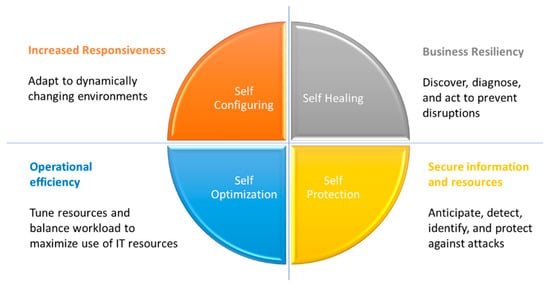Wireless Sensor Network (WSN) is one of the key technologies for IoT implementation. Research and development in IoT are progressing from the research and development in Wireless Sensor Network (WSN) and Mobile Ad Hoc Network (MANET), but still have some specific differences. Compared to WSN and MANET, IoT has a wider scope that includes the device, the communication infrastructure, and the cloud. IoT applications are more diverse. They are different from the WSN and MANET applications, which are domain specific. IoT always involves the internet (IP based network) as the point of interest, so that it often requires multiple network interfaces on the gateway side. IoT also tends to use the existing standard of communication technology infrastructure, which is already available for the internet network.
- Internet of Things
- autonomic computing
- protocol design
- self-organization
- self-optimization
- self-energy-awareness
- self-protection
1. Overview
The autonomic Internet of Things is the creation of self-management capability in the Internet of Things system by embedding some autonomic properties, with the goal of freeing humans from all detail of the operation and management of the system. At same time, this provides a system to always operate on the best performance. This paper presents a review of the recent studies related to the design of network communication protocol, which can support autonomic Internet of Things. Many of the studies come from the research and development in Wireless Sensor Network protocols, as it becomes one of the key technologies for the Internet of Things. The identified autonomic properties are self-organization, self-optimization, and self-protection. We review some protocols with the objective of energy consumption reduction and energy harvesting awareness, as it can support the self-energy-awareness property. As the result, the protocol designs are mapped according to each autonomic property supported, including protocols for MAC layer, protocols for clustering, protocols for routing, and protocols for security. This can be used to map the advances of communication protocol research for the autonomic Internet of Things and to identify the opportunities for future research.
2. Wireless Sensor Network
3. Autonomic Computing Concept

4. Conclusions
References
- Minerva, R.; Biru, A.; Rotondi, D. Towards a Definition of the Internet of Things (IoT). IEEE Internet Initiat. 2015, 1, 1–86.
- Stankovic, J.A.; Stankovic, J.A. Research Directions for the Internet of Things. IEEE Internet Things J. 2014, 1, 3–9.
- Middleton, P.; Kjeldsen, P.; Tully, J.; Findings, K. Forecast: The Internet of Things, Worldwide. 2013. Available online: https://www.gartner.com/en/documents/2625419/forecast-the-internet-of-things-worldwide-2013 (accessed on 1 July 2020).
- Fortune Business Insights. Global IoT Market to Be Worth USD 1463.19 Billion by 2027. 2021. Available online: https://www.globenewswire.com/en/news-release/2021/04/08/2206579/0/en/Global-IoT-Market-to-be-Worth-USD-1-463-19-Billion-by-2027-at-24-9-CAGR-Demand-for-Real-time-Insights-to-Spur-Growth-says-Fortune-Business-Insights.html (accessed on 1 June 2021).
- Kephart, J.; Chess, D. The vision of autonomic computing. Computer 2003, 36, 41–50.
- Gilalkar, S.S. Autonomic Computing Architecture. Available online: https://ininet.org/contents-abstract-introduction-what-is-autonomic-computing-key.html (accessed on 2 June 2021).
